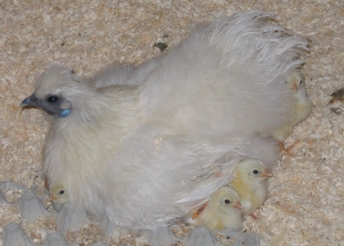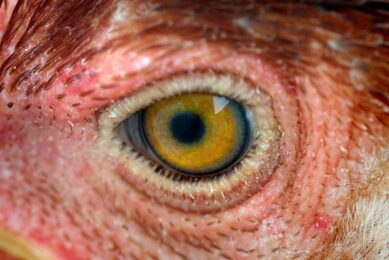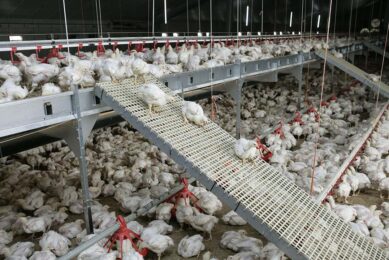Preventing feather pecking in laying hens

With an increase of keeping layers in free range systems, the incidence of feather pecking also increases. Research on this matter indicates, however, that breeding for low mortality and providing natural rearing conditions, results in less pecking and cannibalism. Translating these findings into commercial practice is the next step.
By Dr. Bas Rodenburg , Animal Breeding and Genomics Centre, Wageningen University, the Netherlands
Feather pecking and cannibalism remain major welfare issues in the laying hen business. In the EU, conventional cages will be prohibited from 2012 and beak trimming will likely be prohibited in the near future. In large flocks of birds with intact beaks, feather pecking and cannibalism are much more difficult to control, which will probably result in more feather damage and increased mortality levels.
Different forms of bird-to-bird pecking can be distinguished. Gentle feather pecking is characterised by gentle pecks to the tips of the feathers. This form of feather pecking usually does not result in much feather damage, but can develop into stereotyped gentle feather pecking, which is characterised by repeated pecking at the same spot and can continue for hours. The more damaging form, is severe feather pecking. This is characterised by forceful pecks and vigorous pulls, which often result in removal of the feathers. The plucked feathers are frequently eaten by the pecker. In the denuded body areas of the victim, cannibalistic tissue pecking can develop, resulting in the wounding and death of the victim. A separate form of bird-to-bird pecking is aggressive pecking. Aggressive pecks are directed to the head or neck of the recipient and are used to maintain the dominance hierarchy. Aggressive pecking usually results in little damage in laying hens. So, feather pecking and cannibalism should not be confused with aggressive pecking.
Foraging behaviour
If feather pecking is not aggressive pecking, what is the motivation behind feather pecking behaviour? There is increasing evidence that foraging behaviour plays a central role in the development of feather pecking. Modern laying hens do not need to show foraging behaviour, consisting of ground pecking and scratching, to obtain their feed. Like their wild ancestors, the jungle fowl, however, they remain highly motivated to perform this behaviour. Foraging can take up 65% of the birds’ daytime in the wild. In the 1980’s, Blokhuis showed that birds that have access to foraging material, show much less feather pecking than birds kept in a barren environment. This indicates that birds tend to redirect their foraging pecks to feathers if they lack the opportunity for foraging on the ground.
Recently, Newberry and colleagues described that birds that showed much foraging as a chick also developed more severe feather pecking as adult laying hens, confirming the relationship between foraging and feather pecking. Furthermore, relationships have been found between feather pecking and feather eating, confirming the link with foraging and feeding. Harlander-Matauschek and colleagues found that birds from a high feather pecking line have a stronger motivation to eat feathers than birds from a low feather pecking line and that feather eating has positive effects on gut motility, similar to the effects of roughage. Relationships between feather pecking and feeding were also demonstrated by van Krimpen and colleagues who found that the onset of feather pecking could be postponed by diluting the diet during rearing and by adding fibre to the diet during the laying period.
Genetic selection
But what about individual differences in the propensity to develop feather pecking? Not all birds seem equally ‘at risk’ to develop feather pecking. It seems that especially those birds that are sensitive to fear-inducing or stressful stimuli in the environment are more at risk. Birds that show freezing behaviour in an open-field test at young age, indicating increased fearfulness, are more likely to develop feather pecking when they are adult. In 2006 we began to study the effects of genetic selection and of rearing conditions on this propensity to develop feather pecking.
The aim of this research was to see if we could reduce feather pecking by applying novel breeding and rearing methods. For this research, we used laying hens from a selection experiment set up at Wageningen University in collaboration with Institut de Sélection Animale (ISA) of Hendrix Genetics. In this selection experiment, a white leghorn line was selected on low mortality in group housing for four generations. This low mortality line was then compared with a commercial control line, mainly selected on production traits. We studied these lines in floor pens in two different rearing environments; with a foster mother or without a foster mother.
Targeting to environment
Interestingly, we found that foraging behaviour during the first four weeks of life was stimulated both by selection on low mortality and by brooding by a foster mother, but that this did not lead to more feather pecking. It seemed that these birds better learned to target their pecks to the environment, instead of to other birds. In the open-field test, birds from the low mortality line were more active than birds from the control line, indicating lower fearfulness in the low mortality line (Figure 1).
This fits with our previous findings that indicated a relationship between fearfulness and feather pecking. Similar to the low mortality line, brooded chicks were less fearful in the open-field test compared with non-brooded chicks. When birds were subjected to a stress test as adults (30 weeks of age), the control line also showed a stronger stress response than the low mortality line. Feather damage was limited in this experiment, but there were quite some problems with cannibalistic toe pecking. Levels of toe pecking were much lower in the low mortality line than in the control line.
Translating positive cues
Together, these results show that both selection on low mortality and brooding by a foster hen result in birds that are less sensitive to fear and stress and better learn to direct their pecking behaviour to the environment and not to the body of other birds. Regarding the positive effects of brooding, the challenge will be to translate some of the positive cues that the mother provides (dark shelter, stimulation of foraging, reduction of fear) for application in commercial systems. In this way, selection on low mortality and improved rearing conditions offer promising solutions for feather pecking and cannibalism in laying hens.
Further research on predicting performance In a new research project that started in 2010, Wageningen University collaborates with Utrecht University, Groningen University and Livestock Research in Lelystad, to translate the results of scientific research on feather pecking to commercial practice. In collaboration with Ter Heerdt Hatchery and Pullet Rearing BV, the aim of this project is to investigate if early predictors of feather pecking in commercial rearing flocks can be found, using ISA breeding stock. The research starts with observations on the parent stock and follows the offspring from hatching egg to adult laying hen. Similar to previous studies, the focus will be on the development of foraging behaviour, pecking behaviour and the ability to cope with fear and stress. Further, this study will examine how to optimise rearing conditions to minimise the risk of feather pecking during the laying period. The aim of this project is to develop tools that the poultry industry can use to better predict performance of laying hens in non-cage systems. |
Join 31,000+ subscribers
Subscribe to our newsletter to stay updated about all the need-to-know content in the poultry sector, three times a week. Beheer
Beheer








 WP Admin
WP Admin  Bewerk bericht
Bewerk bericht